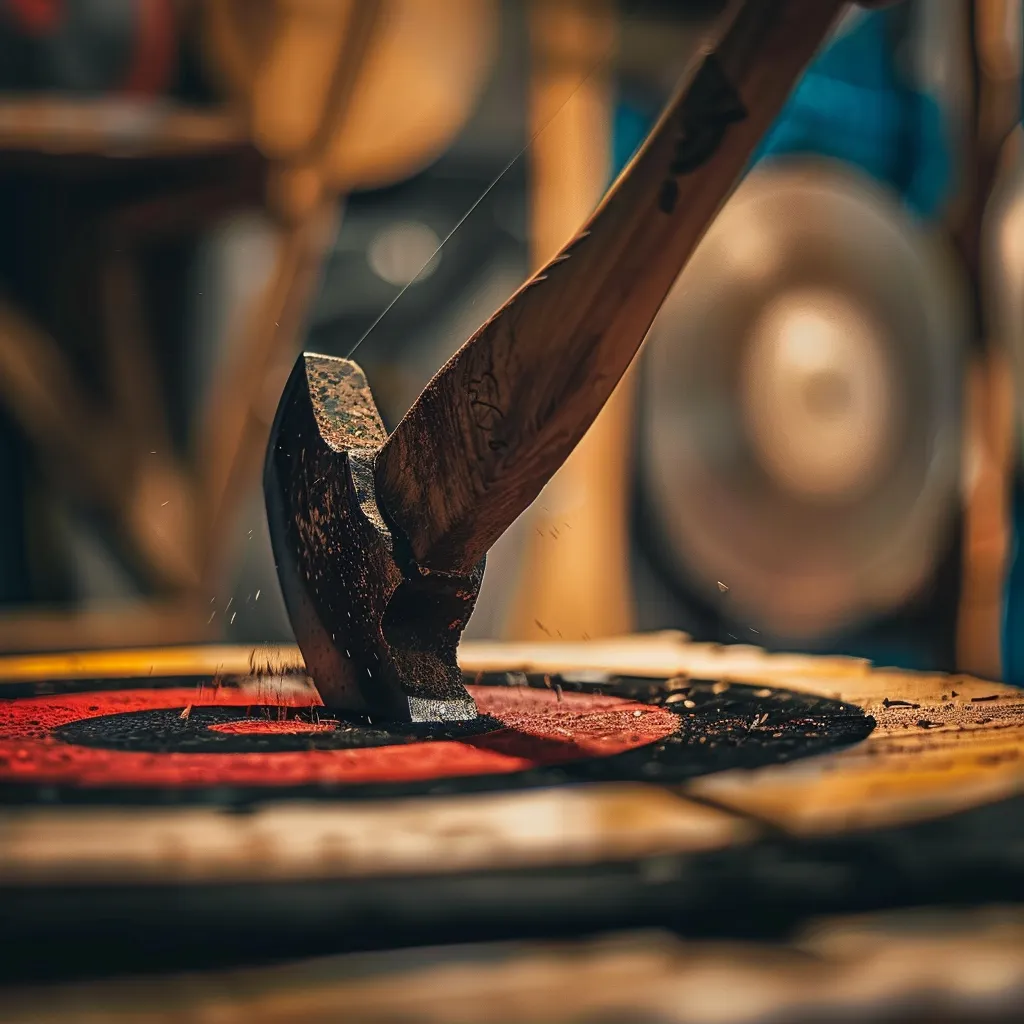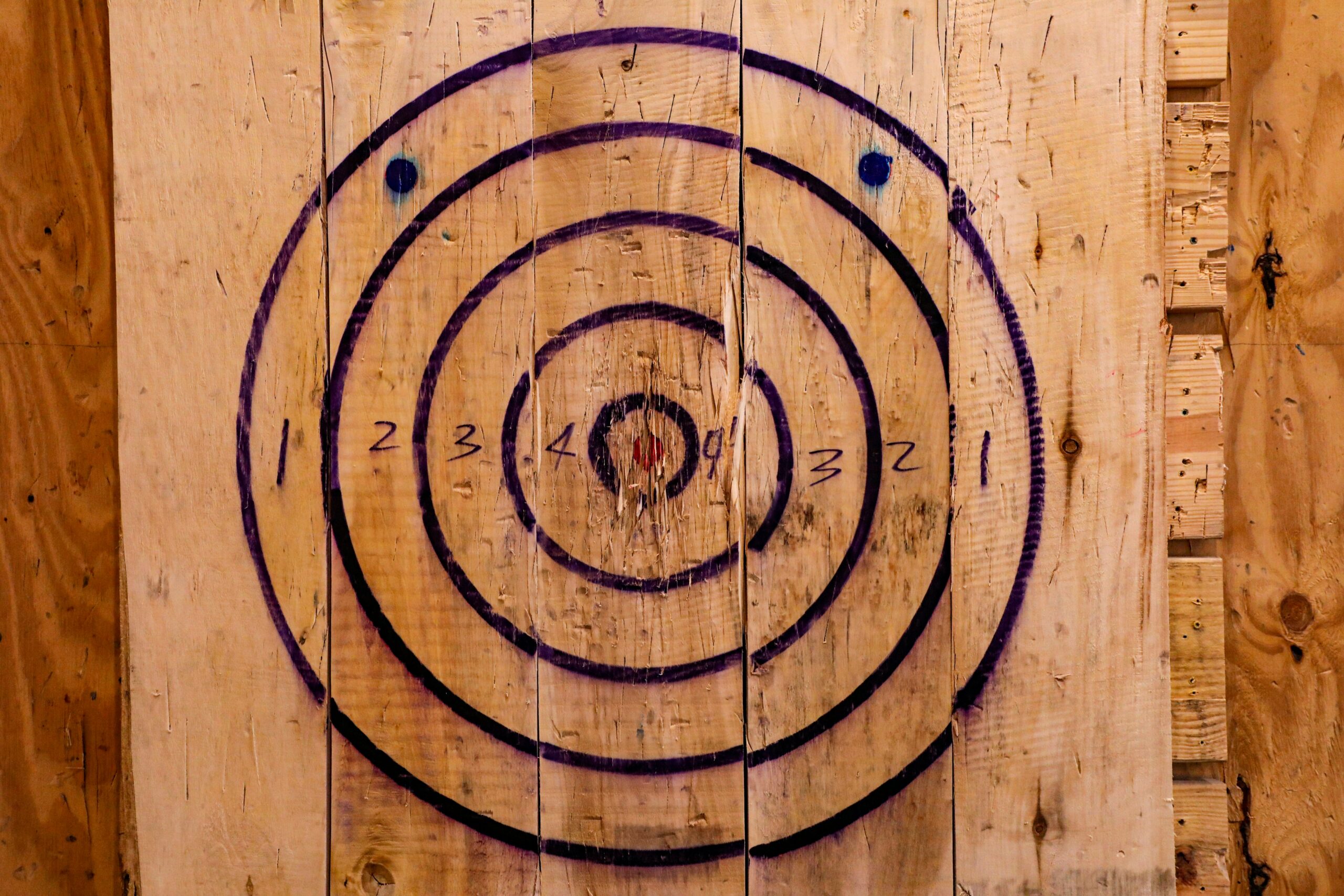Are you struggling to hit the bullseye consistently when axe throwing? This guide will sharpen your skills and boost your axe-throwing accuracy. We’ll cover essential techniques for perfecting your throw, developing consistency, and adapting to different environments.
Mastering these methods will improve your control over the sport and help you achieve fluid, precise throws. Whether you’re a beginner or looking to refine your finger placement, this article will help you become a more accurate axe thrower.
Key Takeaways
- Mastering fundamentals like stance, grip, and eye alignment is crucial for axe-throwing accuracy
- Consistent practice and building muscle memory are essential for developing precise throwing techniques
- Adapting to environmental factors like distance and weather conditions improves overall throwing performance
- Advanced techniques such as refining release timing and incorporating footwork enhance throwing precision
- Setting clear goals and seeking guidance from experienced throwers accelerates skill development
Understanding the Fundamentals of Axe Throwing Accuracy

Mastering axe-throwing accuracy requires understanding key fundamentals. These include establishing a stable stance for better control, selecting the ideal axe weight, mastering the grip for optimal release, and aligning your eyes with the target. Throwers can develop muscle memory and improve their tool handling by focusing on these elements, leading to more precise throws.
Establishing a Stable Stance for Better Control
A stable stance forms the foundation of accurate axe throwing. Throwers should position their feet shoulder-width apart, with the dominant foot slightly forward, allowing for better balance and control during the release. Maintaining a slight bend in the knees helps absorb movement and ensures consistency in throws.
Selecting the Ideal Axe for Precision Throws
Choosing the right axe is crucial for precision throws and hitting the bullseye consistently. The ideal axe should have a balanced weight distribution, allowing for smooth rotation during flight. Throwers should select an axe that feels comfortable in their hand and complements their throwing motion. Regular practice with the chosen axe helps build muscle memory, enhancing accuracy over time.
Mastering the Grip for Optimal Release
Mastering the grip is crucial for optimal axe-throwing accuracy. Throwers should experiment with different hand positions to find the most comfortable and effective hold. The grip should be firm but not tight, allowing for a smooth release.
Proper hand placement on the axe handle, usually near the knee of the thrower when standing, ensures better control and consistency. As throwers gain knowledge and experience, they can adjust their grip based on the type of wood used in the target and the specific axe they are throwing.
Perfecting Your Throwing Technique for Precise Hits

Perfecting throwing technique is crucial for precise axe throwing. This section covers a step-by-step guide to flawless throws, controlling axe rotation, one-handed and two-handed methods, and correcting common errors. Proper clothing, thumb placement, and shoulder alignment contribute to improved skill and trajectory control. Mastering these techniques enhances accuracy and consistency in axe throwing.
Step-by-Step Guide to a Flawless Throw
Expert axe throwers follow a precise step-by-step guide for a flawless throw. The process begins with proper stance and grip, followed by a smooth arm motion and controlled release. To achieve accuracy, throwers must focus on consistent form and practice regularly:
- Establish a stable stance
- Grip the axe correctly
- Raise the axe above the head
- Bring the arm forward in a smooth motion
- Release the axe at eye level
- Follow through with the throwing arm
Controlling Axe Rotation for Consistency
Controlling axe rotation is essential for consistent throws. Throwers must adjust their release point and wrist movement to achieve the desired rotations. The goal is to have the axe complete one full rotation before hitting the target. Throwers can practice different release points and wrist angles to find the optimal rotation for their throwing style:
Utilizing One-Handed and Two-Handed Throwing Methods
Axe throwers can utilize both one-handed and two-handed throwing methods to improve their accuracy. The one-handed technique offers greater control and precision, especially for smaller axes, while the two-handed approach provides more power and stability for larger axes.
Throwers should experiment with both methods to determine which suits their style and the specific axe they are using. Mastering both techniques allows for versatility in different throwing situations and competitions.
Identifying and Correcting Common Throwing Errors
Identifying and correcting common throwing errors is crucial for improving axe-throwing accuracy. Throwers often struggle with inconsistent release points, improper follow-through, or incorrect axe rotation.
By recognizing these issues, throwers can make adjustments to their technique, such as focusing on a smooth arm motion or adjusting their grip. Regular practice and self-analysis help throwers identify and correct these errors, leading to more precise and consistent throws over time.
Developing Consistency Through Practice

Developing consistency in axe throwing requires dedicated practice. This section explores creating effective routines, building muscle memory, and tracking progress. By focusing on these elements, throwers can refine their technique, improve accuracy, and identify areas for enhancement. Regular, purposeful practice is key to mastering axe-throwing skills.
Creating Effective Practice Routines
Creating effective practice routines is essential for developing consistency in axe throwing. Throwers should establish a structured schedule that includes warm-up exercises, target practice, and technique refinement.
A well-designed routine incorporates various distances and target sizes to challenge different aspects of throwing accuracy. Successful routines also include regular feedback and assessment to identify areas for improvement:
- Warm-up exercises
- Target practice at varying distances
- Technique refinement drills
- Feedback and assessment
- Cool-down and reflection
Building Muscle Memory for Repetitive Accuracy
Building muscle memory is crucial for achieving repetitive accuracy in axe throwing. Consistent practice helps throwers develop automatic movements, allowing them to replicate successful throws with minimal conscious effort.
To effectively build muscle memory, throwers should focus on proper form and technique during each practice session, gradually increasing repetitions as they become more comfortable. Key elements to focus on include maintaining a consistent stance, which establishes the foundation for repeatable throws; using a proper grip to ensure axe control; developing smooth arm motion for fluid throwing; and practicing a controlled release to improve both accuracy and consistency.
Tracking Progress to Identify Improvement Areas
Tracking progress is essential for axe throwers to identify areas for improvement. By keeping detailed records of throw accuracy, rotation consistency, and overall performance, throwers can pinpoint specific aspects of their technique that need refinement.
Many axe throwers use scorecards or digital apps to log their practice sessions, allowing them to analyze trends and make data-driven adjustments to their throwing style. Regular self-assessment and feedback from experienced throwers can also help identify blind spots and accelerate skill development.
Advanced Techniques to Enhance Precision

Advanced techniques enhance axe-throwing precision. Refining release timing improves control while incorporating footwork to stabilize throws. Applying mental focus techniques boosts concentration. These advanced methods help throwers achieve greater accuracy and consistency, taking their skills to the next level.
Refining Release Timing for Better Control
Refining release timing is crucial for better control in axe throwing. Throwers must focus on releasing the axe at the optimal point in their throwing motion to achieve consistent rotation and accuracy.
This involves practicing a smooth, fluid motion and identifying the exact moment when the axe should leave the hand. Advanced throwers often use slow-motion video analysis to fine-tune their release timing, allowing them to make micro-adjustments that significantly improve their precision.
Incorporating Footwork to Stabilize Throws
Incorporating proper footwork is essential for stabilizing throws and enhancing axe-throwing accuracy. Advanced throwers utilize a balanced stance and controlled stepping motion to generate power and maintain consistency. By coordinating their foot placement with the throwing motion, they create a solid foundation for each throw.
This technique allows for better weight transfer and body alignment, resulting in more precise and powerful throws. Experienced throwers often practice footwork drills to refine their movement and improve overall stability during the throwing process.
Applying Mental Focus Techniques for Concentration
Applying mental focus techniques is crucial for enhancing concentration in axe throwing. Advanced throwers use visualization, breathing exercises, and pre-throw routines to maintain focus and improve accuracy.
These techniques help throwers block out distractions, reduce anxiety, and enter a state of flow, leading to more consistent and precise throws. Experienced axe throwers often incorporate the following mental focus techniques into their practice:
- Visualization of successful throws
- Deep breathing exercises for relaxation
- Establishing a consistent pre-throw routine
- Positive self-talk and affirmations
- Mindfulness meditation to improve focus
Conclusion
Mastering axe throwing accuracy requires a solid understanding of fundamental techniques, consistent practice, and adaptability to various conditions. By focusing on proper stance, grip, and throwing techniques, throwers can develop the muscle memory necessary for precise and repeatable throws.
Advanced techniques, such as refining release timing and incorporating mental focus strategies, further enhance accuracy and performance. Ultimately, crafting a personalized training plan with clear goals, specialized drills, and guidance from experienced throwers paves the way for continuous improvement and success in axe throwing.

